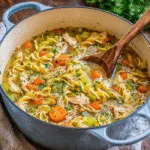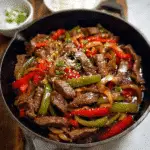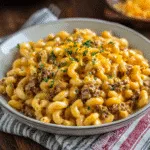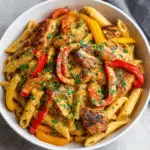Nothing beats the comfort of a warm pizza fresh from the oven, but when you’re trying to hit your daily protein goals, traditional pizza can feel like a guilty pleasure. That’s where High-Protein Sheet Pan Pizza comes in. With a protein-rich crust, nutrient-packed toppings, and a simple sheet pan baking method, this recipe delivers on both taste and nutrition. Whether you’re focused on building muscle, losing weight, or simply eating healthier, this high-protein pizza makes it easy to enjoy your favorite meal without sacrificing your goals.
What is High-Protein Sheet Pan Pizza?
The concept of sheet pan pizza and why it’s trending
Sheet pan pizza is all about convenience — you bake your pizza in one large pan, which means minimal cleanup and a perfect crust every time. The twist with High-Protein Sheet Pan Pizza is the focus on boosting the protein content from the base up. By using ingredients like protein flour, Greek yogurt, and shredded cheese directly in the dough, every slice packs a serious protein punch. This method is especially popular among fitness enthusiasts and meal preppers because it combines the indulgence of pizza with the macros of a balanced meal.
How protein transforms pizza into a balanced meal
Protein plays a vital role in muscle recovery, keeping you fuller for longer, and maintaining steady energy levels. Traditional takeout pizzas are often packed with refined carbs and fats yet fall short on protein, which can leave you feeling hungry soon after eating. By replacing standard flour with protein-rich alternatives and topping your pizza with lean meats, quality cheese, or plant-based protein sources, a High-Protein Sheet Pan Pizza shifts from being an occasional indulgence to a wholesome main meal. With a few smart ingredient swaps, it can fit seamlessly into various eating styles — from keto to vegetarian.
Benefits of High-Protein Sheet Pan Pizza

Nutritional advantages: More than just protein
When you bite into a slice of High-Protein Sheet Pan Pizza, you’re getting more than just a great flavor. This style of pizza offers a balanced combination of macronutrients, helping to keep blood sugar stable and hunger at bay. The higher protein content helps reduce cravings and supports lean muscle growth, while complex carbs from whole grain or protein-enriched flours provide steady energy. The cheese, Greek yogurt, and lean meat toppings contribute calcium, vitamins, and healthy fats, making this pizza a smart choice for health-conscious eaters.
| Nutrient | Benefit | Found In This Pizza |
|---|---|---|
| Protein | Builds muscle & boosts satiety | Protein crust, cheese, toppings |
| Carbs | Provides steady energy | Flour base, vegetables |
| Fats | Supports hormone health | Cheese, olive oil |
| Fiber | Aids digestion | Vegetable toppings, whole grain flour |
Perfect for fitness goals: weight loss, muscle building, and sustained energy
Whether you’re tracking macros for strength training, working toward fat loss, or just looking for more steady energy throughout the day, High-Protein Sheet Pan Pizza fits right in. Its protein-packed crust helps prevent energy dips after eating, while the flexible topping options make it simple to control calorie intake. If your goal is muscle growth, pile on lean meats, cottage cheese, or protein-rich plant options. For weight loss, opt for reduced-fat cheese and load up on colorful vegetables to keep it filling and flavorful. In either case, you can enjoy pizza night without sabotaging your progress.
Key Ingredients for a Protein-Packed Pizza
Protein-rich crust options (chicken, chickpea, protein flour blends)
The foundation of any High-Protein Sheet Pan Pizza is its crust. Instead of relying on refined white flour, this recipe uses a protein-enriched flour blend to boost nutrition from the start. You can also swap in chickpea flour for a gluten-free boost, or even ground chicken for a zero-carb, ultra-high-protein base. The beauty of the sheet pan method is that it bakes evenly, giving you a golden crust with a tender inside every time.
High-protein toppings that elevate both taste and nutrition
This High-Protein Sheet Pan Pizza follows the same balanced approach as the recipe you provided, combining delicious flavor with a nutrient-dense profile. Here’s everything you need to create the ultimate protein-powered pie:
For the crust:
- 1 cup (120g) self-rising protein flour (or plain flour mixed with 2 tsp baking powder and a pinch of salt)
- 1 cup (285g) plain nonfat Greek yogurt
For the toppings:
- ½ cup (125g) pizza sauce or marinara
- 1½ cups (150g) shredded reduced-fat mozzarella cheese
- ½ cup finely prepared lean protein — such as grilled chicken breast strips, crisp turkey pepperoni, seasoned flaked tuna, or spiced plant-based crumbles
- Optional: colorful diced vegetables like bell peppers, onions, spinach, or mushrooms
- Italian seasoning and fresh herbs for a flavor boost
With this ingredient lineup, your High-Protein Sheet Pan Pizza transforms into a well-rounded meal — packed with protein, balanced in carbs, and adaptable to fit any eating style. And the best part? You still get that indulgent, cheesy pizza experience in every single bite.
Step-by-Step Recipe for High-Protein Sheet Pan Pizza
Preparing the protein crust from scratch
The crust is the star of any High-Protein Sheet Pan Pizza, and this version delivers both texture and nutrition.
- Preheat the oven to 425°F (220°C) and lightly grease a large sheet pan.
- Mix the dough by blending self-rising protein flour with plain nonfat Greek yogurt in a mixing bowl. Stir until a thick, slightly sticky dough forms, then transfer to a floured surface and knead gently for 1–2 minutes until smooth.
- Shape the crust by pressing the dough evenly onto the prepared sheet pan, making sure it’s about 1/4-inch thick for the best balance between chewy and crisp.
Assembling your pizza with flavor-packed, high-protein toppings
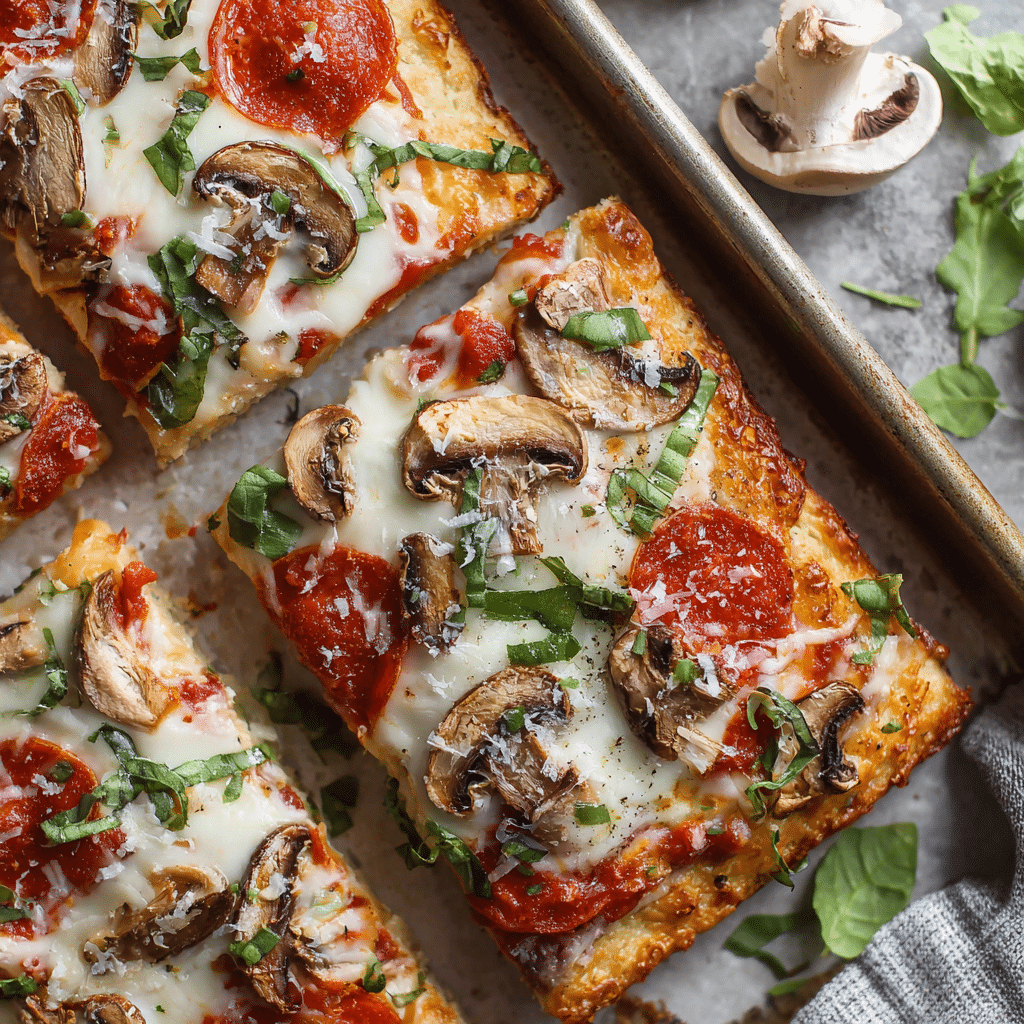
With your crust prepped, it’s time to turn it into a High-Protein Sheet Pan Pizza masterpiece.
- Spread the base: Evenly spoon the pizza sauce across the crust, leaving a slim border around the edges for that classic pizzeria look.
- Add the cheese: Sprinkle shredded reduced-fat mozzarella until the surface is well covered.
- Load on the protein: Scatter your choice of lean protein — think tender chicken breast cubes, zesty turkey pepperoni slices, flaky tuna, or savory plant-based protein crumbles.
- Boost with veggies: Add a pop of color and fiber with toppings like bell peppers, onions, spinach, or mushrooms.
- Season to perfection: Dust generously with Italian seasoning, a hint of garlic powder, and finish with fresh herbs.
- Bake to golden perfection: Place in the oven for 15–18 minutes, until the crust turns golden and the cheese is melted, bubbly, and slightly browned.
- Rest before slicing: Allow the pizza to cool for a few minutes so the toppings set, making for cleaner slices and better presentation.
Variations and Flavor Combinations
Low-carb, gluten-free, and keto-friendly versions
One of the best things about High-Protein Sheet Pan Pizza is how easy it is to adapt for different diets. For a low-carb version, swap the protein flour crust for a ground chicken base mixed with egg and cheese — it bakes into a sturdy, flavorful crust with almost zero carbs. For gluten-free eaters, chickpea flour or almond flour blended with psyllium husk gives structure and keeps protein levels high. If you’re following a keto diet, loading your pizza with high-fat, high-protein toppings like mozzarella, pepperoni, and olives will keep you within your macro limits while still enjoying pizza night.
Vegetarian and vegan protein pizza ideas
If you prefer plant-based eating, your High-Protein Sheet Pan Pizza can still be loaded with muscle-friendly nutrients. Use protein-rich crust blends made from chickpea flour, pea protein powder, or soy flour. Top with dairy-free mozzarella and pile on beans, lentils, or tofu cubes for a hearty bite. For extra depth of flavor, roast your vegetables before adding them to the pizza — caramelized onions, sweet peppers, and zucchini pair perfectly with vegan cheese.
By mixing and matching these variations, you can enjoy High-Protein Sheet Pan Pizza any night of the week while keeping your dietary needs and flavor preferences in balance.
Print
High-Protein Sheet Pan Pizza
- Total Time: 25 minutes
- Yield: 8 slices
Description
This High-Protein Sheet Pan Pizza is a healthy, delicious twist on a classic favorite. With a protein-packed crust made from protein flour and Greek yogurt, plus customizable lean toppings, it’s perfect for busy weeknights or fueling your fitness goals — ready in just 25 minutes.
Ingredients
- 1 cup (120g) self-rising protein flour (or plain flour + 2 tsp baking powder + pinch of salt)
- 1 cup (285g) plain nonfat Greek yogurt
- 1/2 cup (125g) pizza sauce or marinara
- 1 1/2 cups (150g) shredded reduced-fat mozzarella cheese
- 1/2 cup lean protein toppings (chicken breast, turkey pepperoni, tuna, or plant-based alternatives)
- Optional: diced vegetables (bell peppers, onions, spinach, mushrooms)
- Italian seasoning and fresh herbs, to taste
Instructions
- Preheat the Oven: Set your oven to 425°F (220°C) and lightly grease a large sheet pan.
- Make the Dough: In a mixing bowl, combine the protein flour and Greek yogurt. Stir until a thick dough forms, then knead lightly on a floured surface for 1–2 minutes.
- Shape the Crust: Press the dough evenly into the prepared sheet pan, about 1/4-inch thick.
- Assemble the Pizza: Spread pizza sauce evenly, top with mozzarella cheese, add lean proteins, and include vegetables if desired. Season with Italian herbs.
- Bake: Place in the oven for 15–18 minutes, or until the crust is golden and the cheese is melted and bubbly.
- Slice and Serve: Let your High-Protein Sheet Pan Pizza cool for a few minutes, then slice and enjoy.
Notes
For extra crispiness, pre-bake the crust for 5–7 minutes before adding toppings. Drain vegetables well to avoid a soggy base. For more flavor, brush the crust edges with olive oil before baking.
- Prep Time: 10 minutes
- Cook Time: 15 minutes
- Category: Main Dish
- Method: Baking
- Cuisine: American
High-Protein Sheet Pan Pizza for Different Diets
Macros and calorie breakdown for common variations
No matter your health goals, High-Protein Sheet Pan Pizza can be customized to hit your ideal macronutrient ratios. A standard recipe with protein flour, Greek yogurt, reduced-fat mozzarella, and lean chicken breast offers roughly:
| Version | Calories | Protein | Carbs | Fat | Fiber |
|---|---|---|---|---|---|
| Standard | 280 per slice | 28g | 22g | 9g | 3g |
| Low-carb/keto | 250 per slice | 32g | 6g | 12g | 2g |
| Vegetarian | 260 per slice | 25g | 24g | 8g | 4g |
| Vegan | 240 per slice | 23g | 25g | 7g | 5g |
This breakdown shows that High-Protein Sheet Pan Pizza doesn’t just taste good — it can also align perfectly with your nutrition plan.
Adapting the Recipe for High-Fiber, Paleo, and Dairy-Free Diets
For a high-fiber upgrade, mix flaxseed meal or oat fiber into the crust and pile on vegetables such as broccoli, artichokes, and spinach. To create a paleo-friendly High-Protein Sheet Pan Pizza, skip the dairy cheese, use almond flour blended with eggs for the crust, and finish with roasted vegetables and grilled chicken. For a dairy-free version, substitute Greek yogurt with unsweetened coconut yogurt and replace mozzarella with a dairy-free shredded cheese that melts just as well.
No matter the variation, the essence stays consistent: High-Protein Sheet Pan Pizza brings adaptability, rich flavor, and sustained energy in every bite.
If you’re looking for another satisfying high-protein dinner, try our One-Pot Chicken Alfredo Pasta for a creamy, comforting alternative.
Troubleshooting Common Pizza Problems
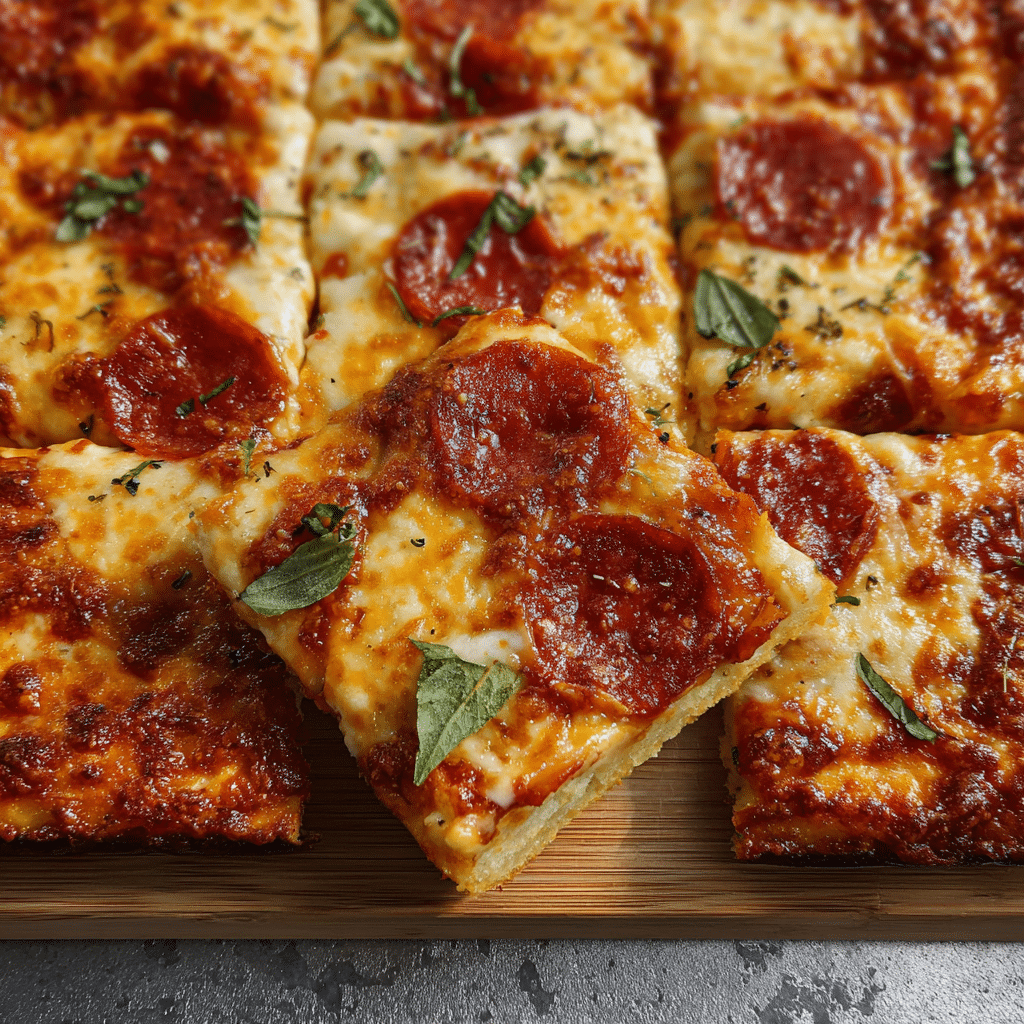
Even the most dedicated home cook can run into challenges when making High-Protein Sheet Pan Pizza. The good news? Every problem has a simple solution. Whether it’s a soggy crust, uneven cooking, or bland toppings, you can get back to perfect pizza night with these tips.
Why your crust might be soggy and how to fix it
One of the most common issues with High-Protein Sheet Pan Pizza is excess moisture in the crust. This usually happens when toppings release water during baking or when the crust is too thick. To prevent this:
- Pre-bake the crust for 5–7 minutes before adding sauce and toppings. This seals the surface and keeps moisture from soaking in.
- Drain and pat dry any vegetables like mushrooms or spinach before adding them.
- Avoid overloading the pizza with sauce — 1/2 cup is plenty for a standard sheet pan.
If you love crispy bases, consider baking your High-Protein Sheet Pan Pizza on parchment-lined wire racks placed over a baking sheet to allow airflow underneath.
Balancing protein and flavor without drying out the pizza
Another concern with protein-rich doughs is that they can bake up too dry. This happens when the crust is overbaked or when lean proteins are used without enough moisture from toppings. To keep your pizza tender:
- Use reduced-fat mozzarella instead of fat-free — the extra bit of fat improves melt and mouthfeel.
- Add moisture-rich toppings like roasted tomatoes, zucchini, or caramelized onions.
- Brush the edges of the crust with olive oil before baking to lock in tenderness.
If your cheese is browning before the crust is fully cooked, tent the pizza with foil for the last few minutes to prevent burning.
Extra tips for even baking and better presentation
- Always bake in the middle rack of the oven for consistent heat distribution.
- Rotate the sheet pan halfway through baking to prevent hot spots and uneven browning.
- For parties, cut your High-Protein Sheet Pan Pizza into squares instead of triangles — it’s easier to serve and creates bite-sized portions.
Master these troubleshooting techniques, and you’ll find your High-Protein Sheet Pan Pizza turning out restaurant-quality every time.
FAQs
How do you add more protein to pizza?
To boost protein in any pizza, start with a protein-rich crust using ingredients like protein flour, Greek yogurt, or even ground chicken. For toppings, choose lean meats such as chicken breast, turkey pepperoni, tuna, or plant-based protein crumbles. Adding extra cheese or sprinkling hemp seeds can also raise the protein content without drastically changing flavor. With High-Protein Sheet Pan Pizza, these swaps are already built into the recipe.
What is the best high-protein flour for pizza crust?
Self-rising protein flour blends are ideal for High-Protein Sheet Pan Pizza because they provide structure while delivering extra protein per serving. Popular options include whey protein-enriched flour, chickpea flour for gluten-free needs, and soy flour for a plant-based boost. If you can’t find protein flour, mix plain flour with whey or pea protein powder for similar results.
Can I make high-protein sheet pan pizza without dairy?
Absolutely. For a dairy-free High-Protein Sheet Pan Pizza, replace Greek yogurt with unsweetened coconut yogurt in the crust and use dairy-free mozzarella or nutritional yeast for a cheesy flavor. You can still pack in protein with toppings like grilled chicken, tofu, or tempeh, and the texture will remain satisfying.
How many grams of protein are in a serving of sheet pan pizza?
The protein count depends on your ingredients, but a standard High-Protein Sheet Pan Pizza with protein flour, Greek yogurt, reduced-fat mozzarella, and lean chicken averages 25–30 grams of protein per slice. Variations like keto or vegetarian versions may differ slightly, but all offer significantly more protein than traditional pizza.
Conclusion
Whether you’re a fitness enthusiast, a busy parent, or just someone who loves a healthier take on comfort food, High-Protein Sheet Pan Pizza proves you don’t have to sacrifice flavor to meet your nutrition goals. With its protein-packed crust, customizable toppings, and easy sheet pan method, this recipe delivers taste, texture, and nutrition in every bite.
By following the tips and troubleshooting steps we’ve covered, you can make a High-Protein Sheet Pan Pizza that rivals anything from a pizzeria — only with better macros and less guilt. From keto and gluten-free versions to vegan and vegetarian twists, the possibilities are endless.



